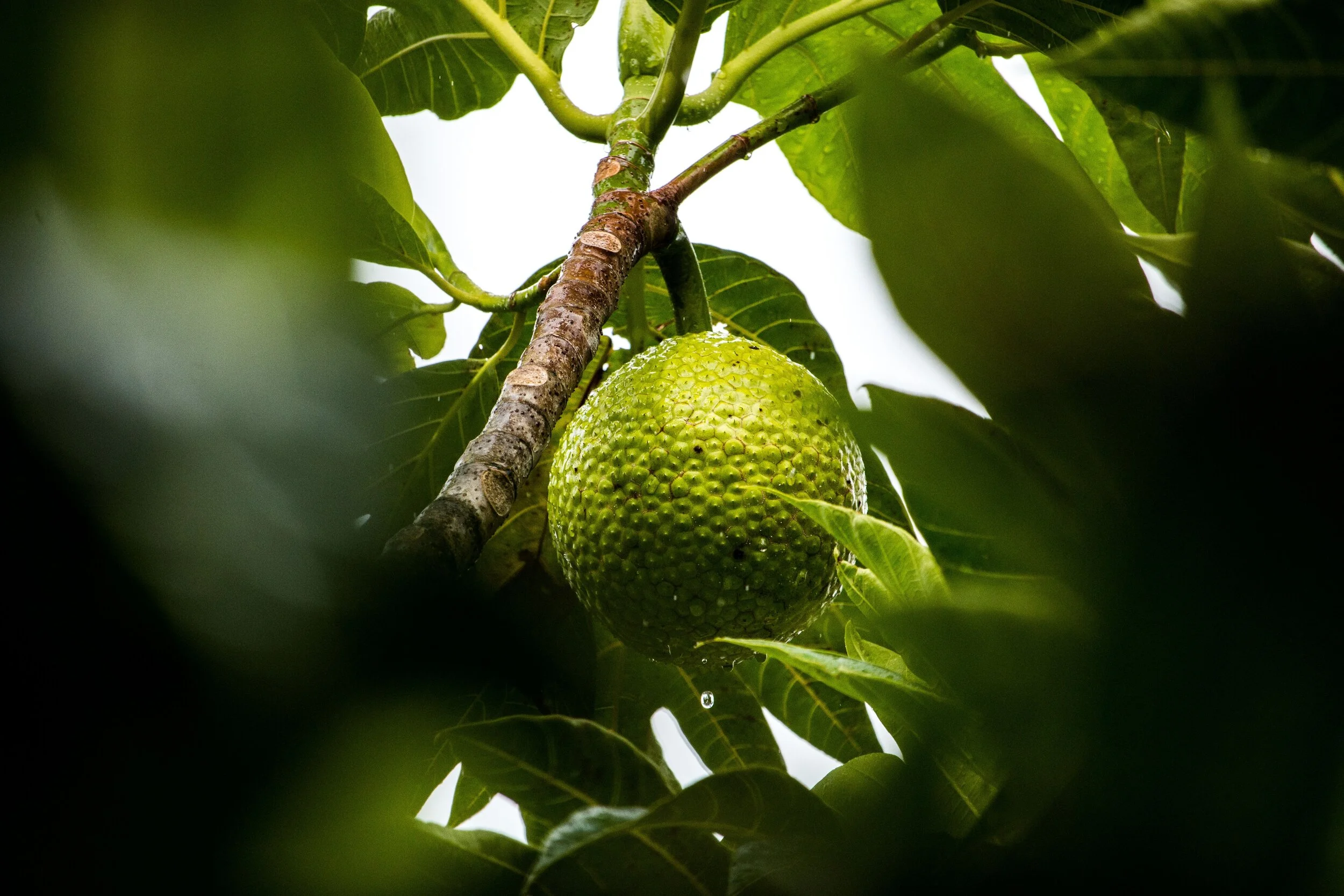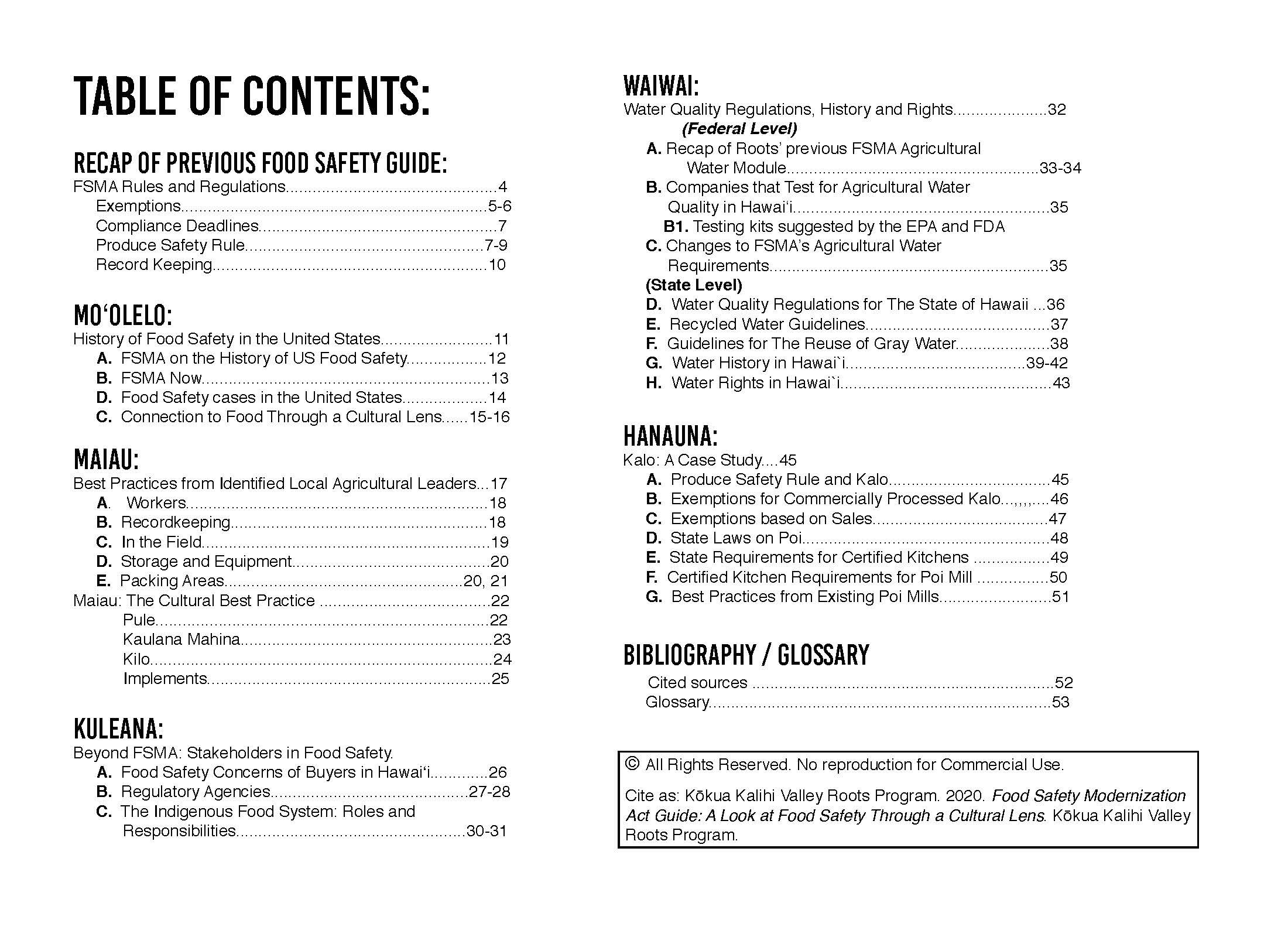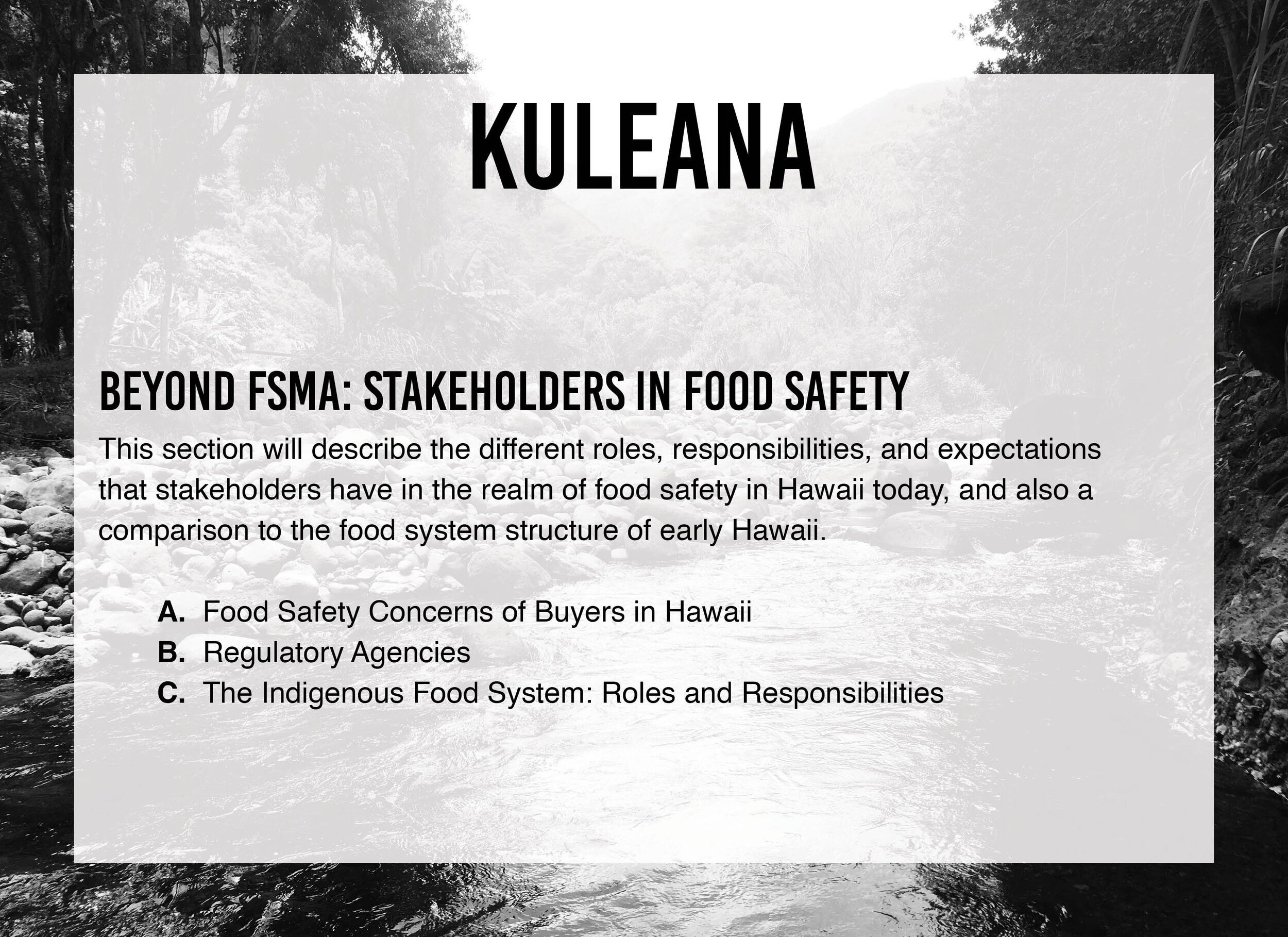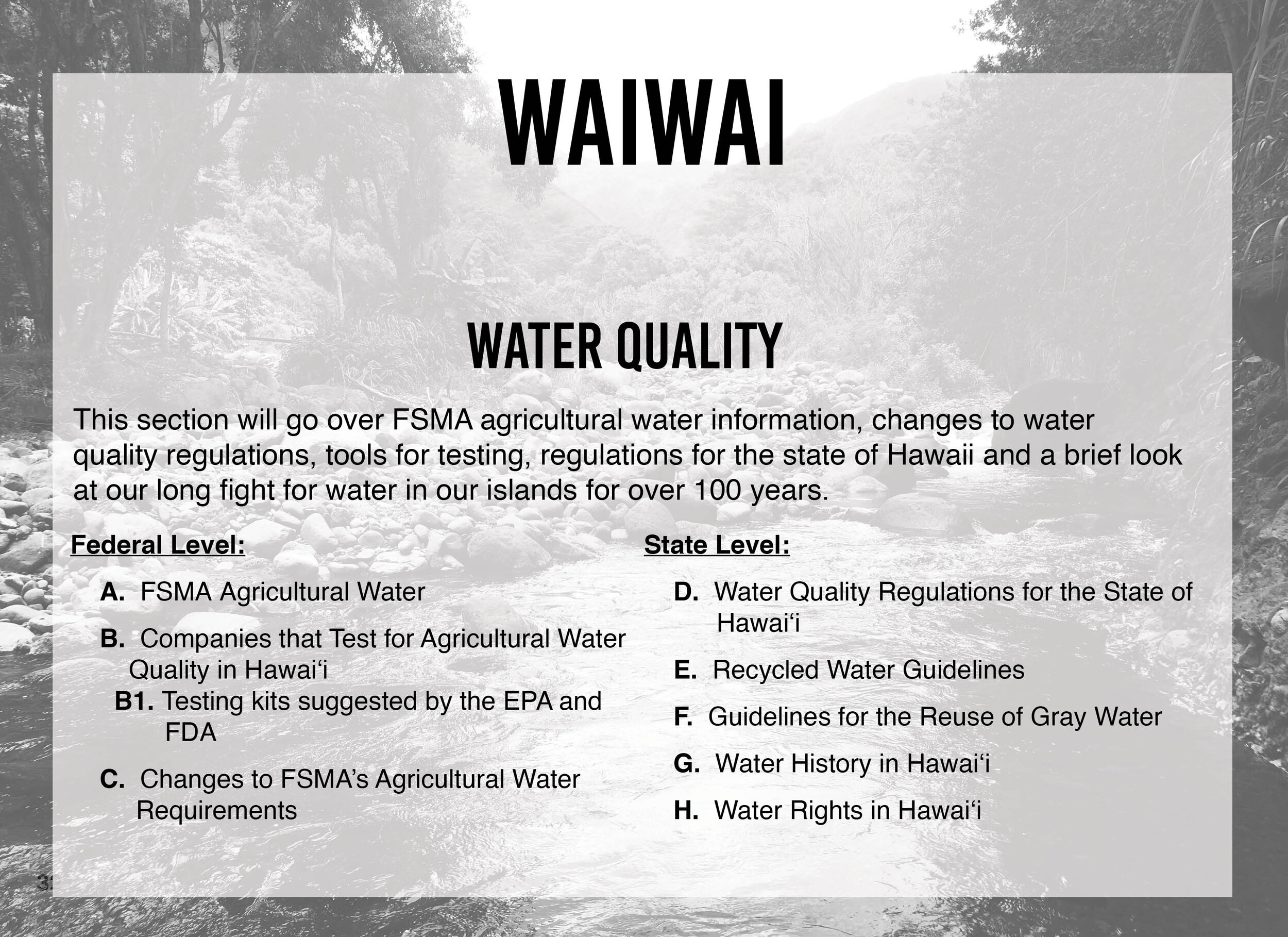“Hawaiians never grew kalo for profit, it was a subsistence approach to growing kalo. And I believe if you tie it all the way back into food safety, its really intentions as to why your doing what you are doing. We need to steward the land in a way that in perpetuity ensures that my children and their children will continue to be able to live subsistence off of that land and with that land ”
Through this page you will be able to:
Download our 2017 and 2021 FSMA Booklets
Watch our food safety videos
Get up to date with regulations and deadlines
Understand cultural values and connection to food safety
Additional local and national resources
Our Manaʻo on Food Safety:
The Food Safety Modernization Act (FSMA) is the largest update of the United States food safety laws in 70 years, primarily focused on regulating raw produce. The goal of food safety regulation is the prevention of foodborne illness and food poisoning (salmonella, E. coli, stomach flu virus, parasites, etc). At Roots, we wanted to expand on the cultural and community definition of food safety, and what that means for a local, resilient, and healthy food system in Hawai‘i. We aim to lift up the meaning of “safe” food as knowing where your food comes from, who grew it, connection to our farmers, our land, and the integrity of how it is grown. Our kūpuna knew how to grow, forage, prepare, and preserve food in ways that were in balance with the natural cycles and rhythms of our food system. What was pono, kept people safe. In this guide we aim to help break down FSMA regulations to make them clearer for small farmers to understand, while remembering the cultural values of this land.
Food Safety Videos
Maiau: Mahiʻai Best practice - Aolani Higgins, Fiore Anderson, and Casey Chikuma of Hoʻoulu ʻĀina, Kalihi
Waiwai: We Value Our Water - Paul Reppun & Charlie Reppun of Waianu Farm, Waiāhole
Hanauna: Kalo and Food Safety - Dean Wilhelm of Hoʻokuaʻāina, Maunawili
Hanauna: Kalo and Community & Hanauna: Poi Production - Nick Reppun of Kākoʻo ʻŌiwi, Heʻeia
booklet download
Table of Contents:
Introduction
What it’s all about
The Produce Safety Rule
Exemptions
Deadlines (Compliance Dates)
Produce Safety Rule
Recordkeeping
Rat lung Worm
Writing a Food Safety Plan
Additional Rsources
This guide will help you:
Learn what the Produce Safety standards and regulations are and figure out if you are exempt.
History of FSMA in the United States
Connection to food through a cultural lens
Learn food safety best practices from local agricultural leaders.
Know your food safety landscape in Hawaiʻi (local buyer concerns and regulatory agencies).
Learn about Hawaiʻi water quality regulations and the history of water management and water rights.
Learn about kalo and poi food safety
regulations and exemptions
food safety through a cultural lens
cultural values
Moʻolelo:
Story, tale, myth, history, tradition, literature, journal, log, essay, record article.
We will be looking at FSMA guidelines that have been created to prevent people from getting sick from eating produce. Additional information has been added to each section that helps look through a cultural lens at what makes our food system safe and robust here in Hawaiʻi.
maiau:
Neat and careful in work; skillful, ingenious, expert; correct, careful, thorough, meticulous tidy.
Being maiau and practicing food safety go hand in hand for the growing, processing and consumption of food. When we look at our food system and the practices of our farmers, we want to make sure that they are not only growing good and healthy food for our community, but that they are also practicing safe practices for their own health and wellbeing.
Throughout this section we will learn from our local agricultural leaders on their best practices. What are the cultural practices we use to ensure that our food system is safe.
Mahiʻai Best Practices
At Hoʻoulu ʻAina, growing the land and growing from the land is an important aspect of what they do for community and for each other. In this video we will learn from our mahiʻaina crew how they practice being maiau in their growing practices.
Pule
Aloha circle and mahalo circle
Seed saving
Kilo ʻāina and kilo mahina
Planting and protecting
Feeding ʻāina
Kanaka irrigation and akua irrigation
Harvesting and washing
Hoʻokupu : honoring ʻāina and community
Aolani Higgins, Fiore Anderson, and Casey Chikuma
Hoʻoulu ʻĀina, Kalihi
kuleana:
Right, privilege, concern, responsibility, authority, liability, interest.
Our kuleana is to provide produce grown and harvested in the safest possible manner. Consumers want to be assured they can trust in the processing methods of a farm. Interviews with local buyers bring light to what they look for when working with farms.
Waiwai:
Goods, property, assets, valuables, value, worth, wealth, importance, benefit.
Ola i ka wai - water is the source of all life. In Hawai‘i water is an important and controversial subject. Traditional views on water usage and ownership are very different than modern day. We will look at FSMA regulations, Hawai‘i state regulations and guidelines, and the historical context of water.
We Value Our Water
Water is the life source of all forms of agriculture, without it nothing can grow. Kalo, fishponds and native ecosystems can all thrive . The Reppun brothers, Charlie and Paul, have been instrumental in restoring stream flow in the Koʻolaupoko area of Oahu. This video highlights their success in the Waiāhole water case and their view on the future of farming.
Charlie and Paul Reppun
Waianu Farm, Waiāhole
HANAUNA:
Generation, relative whose relationship was established several generations previously, ancestry, birth.
Kalo is our older brother and is one of the most important and nutritious complex carbohydrates in Hawaiian culture. The growing of kalo is our guiding principle of what food safety means indigenously. Kalo must be treated with reverence and respect in all aspects of growing and preparation. Rules and regulations are still emerging to accommodate its unique requirements.
Throughout this section we will go over federal regulation and exemptions, state level requirements, and value-added processes through the making of poi.
Kalo and Food Safety
Kalo Is a staple for native Hawaiians and holds an important place in our diet. It is our ancestor, and one of the most nutritious complex carbohydrates. It provides fiber and probiotics that support a heathy gut microbiome. Poi is the processed form. This video will show traditional and modern processes of making poi.
Dean Wilhelm
Hoʻokuaʻāina, Maunawili
Kalo and Community
The future of farming is a participatory food system . In the ahupuaʻa of Heʻeia, Kakoʻo ʻOiwi focuses on restoring cultural connection between land and community through the cultivation of kalo. Their OLA (`Ohana Lo`i Adoption) Program provides space for `ohana to develop and deepen their relationship to food and land. They are able to exercise true sovereignty by growing, tending, harvesting, preparing, cooking and eating their own food.
Poi Production
Kalo Is a staple for native Hawaiians and holds an important place in our diet. It is our ancestor, and one of the most nutritious complex carbohydrates. It provides fiber and probiotics that support a heathy gut microbiome. Poi is the processed form. This video will show traditional and modern processes of making poi.
Nick Reppun
Kakoʻo ʻŌiwi, Heʻeia
Nick Reppun
Kakoʻo ʻŌiwi, Heʻeia
additional resources:
National Food Safety:
Tribal Food Alliance
https://www.nativefoodsafety.org/projects
FSMA Fine Rule on Produce Safety - Standards for the Growing, Harvesting, Packing, and Holding of Produce for Human Consumption
https://www.fda.gov/food/food-safety-modernization-act-fsma/fsma-final-rule-produce-safety
FSMA Fine Rule on Produce Safety -Current Good Manufacturing Practice, Hazard Analysis, and Risk-Based Preventive Controls for Human Food
FSMA Final Rule on Sanitary Transportation of Human and Animal Food
Local Food Safety:
CTAHR Farm Food Safety: Good Agricultural Practices Education - Science-based education for Hawaiʻi growers and handlers
http://manoa.hawaii.edu/ctahr/farmfoodsafety/
CTAHR Farm Food Safety - Publications
http://manoa.hawaii.edu/ctahr/farmfoodsafety/publications/
State of Hawaii, Department of Health - Food Safety Branch, Forms
https://health.hawaii.gov/san/food-information/
Staring a Homemade Food Operation: Hawaii Administrative Rules (HAR) Chapter 11-50 Food Safety Code
KALO:
The Manufacture of Poi From Taro in Hawaiʻi: With special emphasis upon its fermentation (1938)
https://www.ctahr.hawaii.edu/oc/freepubs/pdf/B-070.pdf
Produce Safety Rule (PSR) Exemption for Taro
Water:
State of Hawaiʻi CWB: Water Quality Standards
https://health.hawaii.gov/cwb/files/2013/04/Clean_Water_Branch_HAR_11-54_20141115.pdf
Water Quality Standards Regulations: Hawaii
https://www.epa.gov/wqs-tech/water-quality-standards-regulations-hawaii
Oahu Water Management Plan Update 2015
https://health.hawaii.gov/sdwb/files/2015/09/M03_NSWMPGovWaterConfAug62015.pdf
Ola I Ka Wai: A legal primer for water use and management in Hawaiʻi
https://www.law.hawaii.edu/files/content/news/18470/WaterPrimer.pdf













